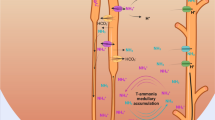Abstract
We investigated the capacity and the localization of N-acetylation of the mercapturic acid precursor S-benzyl-l-cysteine (BC), as well as the tubular reabsorption of this compound in the rat kidney in vivo et situ by renal clearance and continuous microinfusion and microperfusion experiments. In renal clearance experiments, 450 μmol BC was infused intravenously for 180 min. During the time of BC infusion and the following 180 min, the two kidneys excreted 400 μmol or 90% of the infused BC dose as the mercapturate N-acetyl-S-benzyl-l-cysteine (AcBC). Comparison of the amounts of BC and AcBC entering the left kidney via the renal artery with those leaving it via the renal vein and the ureter showed that 0.13±0.04 μmol BC/min (mean ± SEM) was extracted and 0.24±0.08 μmol AcBC/min was formed by one kidney. The intrarenal acetylation can account for the formation of 38% of the mercapturate excreted in the final urine. In additional experiments, 50 pmol/min [14C]BC was microinfused into single superficial tubules at three different sites. During microinfusion into early proximal tubules, the final urine contained 16.3±1.8% of the microinfused radioactivity as AcBC, but no BC. When [14C]BC was microinfused into late proximal tubules, 13.0±2.3% of the infused label was recovered as BC, 28.1±2.3% as AcBC. During microinfusion into early distal tubules, the final urine contained no AcBC, but 90.3±2.1% of the infused [14C]BC was recovered. As the infused BC dose was reabsorbed completely by the high-capacity carrier for neutral amino acids in the proximal convolution, our results show acetylation of the cysteine S-conjugate both by the convoluted and the straight part of the proximal nephron, the capacity for acetylation and/or secretion being almost twice as high in the straight part.
Similar content being viewed by others
References
Barnes MM, James SP, Wood PB (1959) The formation of mercapturic acids. 1. Formation of mercapturic acid and the levels of glutathione in tissues. Biochem J 71:680–690
Boyland E, Chasseaud LF (1969) The role of glutathione and glutathione S-transferases in mercapturic acid biosynthesis. Adv Enzymol 32:173–219
Bray HG, James SP (1960) The formation of mercapturic acids. 4. Deacetylation of mercapturic acids by the rabbit, rat and guinea pig. Biochem J 74:394–397
Duffel MW, Jacoby WB (1982) Cysteine S-conjugate N-acetyl-transferase from rat kidney microsomes. Mol Pharmacol 21:444–448
Golenhofen N, Heuner A, Mildenberger S, Schwegler JS, Silbernagl S (1990) Mercapturic acid formation in cultured opossum kidney cells. Toxicol Lett 53:261
Green RM, Elce JS (1975) Acetylation of S-substituted cysteines by a rat liver and kidney microsomal N-acetyltransferase. Biochem J 147:283–289
Heuner A, Schwegler JS, Mildenberger S, Silbernagl S (1988) Renal handling of S-benzyl-L-cysteine and its mercapturic acid N-acetyl-S-benzyl-L-cysteine. Pflügers Arch 412:R55
Heuner A, Dekant W, Schwegler JS, Silbernagl S (1990) Localization of mercapturic acid formation in the kidney. Kidney Int 37:1161–1162
Hughey RP, Rankin BB, Elce JS, Curthoys NP (1978) Specificity of a particulate rat renal peptidase and its localization along with other enzymes of mercapturic acid synthesis. Arch Biochem Biophys 186:211–217
Inoue M, Okajima K, Morino Y (1981) Renal transtubular transport of mercapturic acid in vivo. Biochim Biophys Acta 641:122–128
Inoue M, Okajima K, Morino Y (1984) Hepato-renal cooperation in biotransformation, membrane transport, and elimination of cysteine S-conjugates of xenobiotics. J Biochem (Tokyo) 95:247–254
Kashgarian M, Stöckle H, Gottschalk CW, Ullrich KJ (1963) Transtubular electrochemical potentials of sodium and chloride in proximal and distal renal tubules of rats during antidiuresis and water diuresis (Diabetes insipidus). Pflügers Arch 277:89–106
Kraus P, Kloft HD (1980) The activity of glutathione-S-transferases in various organs of the rat. Enzyme 25:158–160
Lang F, Greger R, Lechene C, Knox FG (1978) Micropuncture techniques. In: Martinez-Maldonado M (ed) Methods in pharmacology, vol 4B. Plenum, New York, pp 75–103
McKinney LL, Picken JC, Weakley FB, Eldridge AC, Campbell RE, Cowan JC, Biester HE (1959) Possible toxic factor of trichloroethylen-extracted soybean oil meal. J Am Chem Soc 81:909–915
Okajima K, Inoue M, Morino Y (1981) Topology and some properties of the renal brush border membrane-bound peptidase(s) participating in the metabolism of S-carbamidomethyl glutathione. Biochim Biophys Acta 675:379–385
Schaeffer VH, Stevens JL (1987) The transport of S-cysteine conjugates in LLC-PK1 cells and its role in toxicity. Mol Pharmacol 31:506–512
Shen CW, Lewis HB (1946) The metabolism of sulfur. XXXI. The distribution of urinary sulfur and the excretion of keto acids after the oral administration of some derivatives of cystine and methionine to the rabbit. J Biol Chem 165:115–123
Silbernagl S (1988) The renal handling of amino acids and oligopeptides. Physiol Rev 68:911–1007
Silbernagl S, Pfaller W, Heinle H, Wendel A (1978) Topology and function of renal γ-glutamyl transpeptidase. In: Sies H, Wendel A (eds) Functions of glutathione in liver and kidney. Springer, Berlin, Heidelberg, New York, pp 60–69
Sohtell M, Karlmark B, Ulfendahl H (1983) FITC-inulin as a kidney tubule marker in the rat. Acta Physiol Scand 119:313–316
Stekol JA (1940) Conversion of S-benzylglutathione to benzyl-mercapturic acid in the rat. Proc Soc Exp Biol Med 43:108–110
Tomisawa H, Suzuki S, Ichihara S, Fukazawa H, Tateishi M (1984) Purification and characterization of C-S lyase from Fusobacterium varium. A C-S cleavage enzyme of cysteine conjugates and some S-containing amino acids. J Biol Chem 259:2588–2593
Wendel A, Heinle H, Silbernagl S (1977) The degradation of glutathione derivatives in the rat kidney. Hoppe-Seyler's Z Physiol Chem 358:1413–1414
Wood JL (1970) Biochemistry of mercapturic acid formation. In: Fishman WH (ed) Metabolic conjugation and metabolic hydrolysis, vol II. Academic Press, New York, pp 261–299
Zbarsky SH, Young L (1943) Mercapturic acids. I. The synthesis of phenyl-L-cysteine and L-phenylmercapturic acid. J Biol Chem 151:211–215
Author information
Authors and Affiliations
Rights and permissions
About this article
Cite this article
Heuner, A., Dekant, W., Schwegler, J.S. et al. Localization and capacity of the last step of mercapturic acid biosynthesis and the reabsorption and acetylation of cysteine S-conjugates in the rat kidney. Pflugers Arch. 417, 523–527 (1991). https://doi.org/10.1007/BF00370949
Received:
Revised:
Accepted:
Issue Date:
DOI: https://doi.org/10.1007/BF00370949




